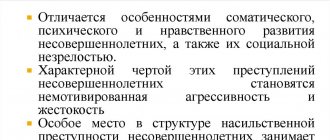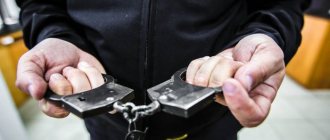Initiation of a criminal case regarding theft
The basis for initiating a criminal case for theft may be a written statement from the injured party and the presence of signs of a crime, which include:
- breaking into;
- violation of the order of things in the house;
- lack of property.
If there is sufficient evidence that the theft has been committed, then a criminal case is opened immediately; when they are not enough, then a check is carried out based on the fact of the victim’s statement.
What circumstances must be proven when investigating thefts?
During the investigation of a criminal act, the investigation will need to determine and prove the following facts:
- who is the injured party;
- what was stolen and what is the total value of the stolen property;
- time of commission of the criminal act;
- method of committing the crime;
- who is the criminal;
- whether one person committed the crime or whether it was a group of people;
- what is the extent of the damage;
- where is the stolen property currently located?
- what prompted the criminal to take possession of someone else's property.
If the statement about the commission of a crime was submitted by the victim much later than it took place, then the investigator must find out the reasons for the delay.
Features of investigative tactics in cases of theft
Inspection of the scene of the incident. An inspection of the crime scene is usually carried out before a criminal case is initiated. During the investigation, an inspection of the crime scene can be carried out both immediately after the initiation of a criminal case, and at its various stages (in the initial or additional additional mode).
The inspection is most effective when it is carried out by an investigative team, which includes an investigator, criminal investigation officers, a forensic specialist, a dog handler with a service dog, and a local inspector. In case of theft from institutions, enterprises and in some other cases, it is advisable for an OED and PC employee to participate in the inspection of the scene.
Even before the inspection begins, the investigator is obliged to collect more detailed information about the theft in order to determine the inspection plan, the boundaries of the inspection area, and decide where and what traces can be found. Having received a report of a theft, the investigator, even before leaving for the scene, must:
- Take care of the security of the scene of the incident.
- Decide on the issue of persons who must travel with him to participate in the inspection.
Objects of inspection when committing thefts can be:
Premises:
- courtyard and locks, bars, shutters, attic-ceiling or assembly floors, walls, floors;
- safes, tables, cabinets, drawers, shelves, other storage of things, money, other valuables;
- communication means and devices, alarm;
- other objects with which the criminal could interact, used them during penetration into the premises, searching for items of theft, taking possession of it, carrying it out, overcoming various obstacles along the way of movement (for example, abandoned storage breaking tools, things falling out of a pocket, documents, ropes and other packaging material, for stolen items, etc.).
Outdoor areas:
- sections of the road area along which the criminal arrived at the scene of the incident and departed from there;
- a vehicle abandoned by him, other items used in the commission of a crime;
- cracked safes taken from the scene of the incident, places of discovery of the latter, places of preparation for committing a crime, vehicles that are objects not only of theft but also of other crimes against property, objects in which criminals hid after committing a crime, and objects located here (attics, ditches , landfills, etc.);
- traces characteristic of a break-in, as well as display traces, traces of human secretions;
- fences and other barriers to the scene of the incident;
- parts of any objects preserved unchanged and changed during the crime, elements separated from them, particles, remains of objects, the destruction of which was directed by the criminal’s activity.
Upon arrival at the scene of the incident, first of all, the investigator:
- conducts a survey of persons present at the scene of the incident in order to obtain information necessary to determine the sequence and nature of his actions, as well as to carry out urgent operational measures aimed at identifying witnesses, hot pursuit of the criminal and search for the stolen person;
- identifies whether changes were made to the situation at the scene from the moment the theft was discovered until the arrival of the investigator.
The results of the inspection of the scene of the incident are recorded by drawing up a detailed inspection protocol, photographing the situation at the scene of the incident, drawing plans and diagrams.
Packing materials, containers from stolen property, passports, labels, labels, and in some cases, samples of stolen property are included in the inspection protocol.
Another initial investigative action is the interrogation of the person in whose jurisdiction the stolen property was located or the victim.
When questioning the victim, you should find out the following:
- When, where and what was stolen, generic and individual characteristics?
- The value of what was stolen?
- How did the criminal get to the scene of the theft, what damage did he do?
- What changes have occurred in the scene of the incident?
- Where was the victim during the theft?
- How was the apartment closed?
- Where did the theft come from?
- By whom, when and under what circumstances was the theft discovered, and who was the first victim to report what had happened?
- Have strangers visited the site of the theft whose behavior aroused suspicion, what are their examples (for example: a plumber)?
- Who, in the opinion of the victim, could have committed the theft? (The investigator should pay special attention to the victim’s guesses and suspicions).
In cases of theft, it is also determined whether there is a person living in the neighborhood who might know that the victim has valuables or goods, whether anyone has shown interest in them, and which of the strangers was the last to visit the property.
When interrogating financially responsible persons, it is established what the organization’s operating mode is, who has access to the storage facility, the procedure for protecting the facility, whether any suspicious persons work in this organization and whether such persons have recently quit?
It is also very important to correctly interrogate the witness(es), who can be divided into:
- Eyewitnesses and other witnesses who know anything about the theft.
- Persons characterizing the victim.
- Persons testifying about the suspect and his lifestyle.
The first group includes those people who may have seen or heard something, may know something and who can at least help the investigation in some way (for example: a neighbor who lives next to a burglarized apartment heard in what - at a certain time, a sound similar to a blow, or maybe from the window of my apartment I saw a stranger who was entering the entrance of the house at that time).
The second group includes those persons who can characterize the victim with their testimony (for example: the victim is a chronic alcoholic, when there is not enough money, he sells valuable household items, the next day he does not remember where they went?).
The third group includes persons who, with their testimony, can characterize the identity of the suspect (for example: persons who drink alcoholic beverages, persons who use narcotic drugs and other information).
During the interrogation of materially responsible persons and managers of enterprises and institutions, the operating mode of the enterprise or institution, the provision of security of the facility, the nature and quantity of the stolen property, the availability of documents for this or that property at the facility, including the stolen property, are established. During the interrogation of persons who are not financially responsible persons (workers, cleaners), it becomes clear whether the values indicated in the statement as stolen were at the facility, and what they know about the circumstances of the theft.
When questioning employees of private security or a security company, the investigator must establish the security regime for the facility, the specific circumstances of duty on the day of the theft, including:
- serviceability of the security alarm system;
- safety of constipation and locks;
- actions of security after detection of theft;
- whether there have been previous thefts on the territory of the facility or near it by any suspicious people.
When conducting interrogations of this circle of witnesses, one should take into account their possible biased attitude towards the case, due to the fact that, when working at an object that has been theft, they sometimes shield themselves and their colleagues by showing their work in a favorable light. There are also cases when such witnesses, being dissatisfied with something at work, do not objectively criticize their managers and colleagues, trying to show themselves as honest people.
The next important investigative action is the interrogation of the suspect (accused). Interrogation in cases of theft usually begins with finding out where the interrogated person was at the time of the theft, and if he pleads not guilty and puts forward an alibi, the smallest details associated with this event are clarified in order to verify his testimony. To incriminate the suspect (accused), material evidence found at the scene, seized during a search and examination, testimony of eyewitnesses and other witnesses interrogated to verify an alibi are used.
If the suspect (accused) pleads guilty to the theft, then all the circumstances of the preparation for its commission, the location of the stolen property, the instruments of the crime, and accomplices are clarified. In such situations, it is always advisable to ask the interrogated person whether he has committed other crimes. And if the answer is positive, find out their circumstances for the purpose of subsequent verification.
The next initial investigative action is a search. When conducting a search, it is necessary to take measures to detect the stolen property, its parts and accessories, possible weapons for committing thefts (burglary tools and tools - files, master keys, keys, etc.), shoes and clothes of the thief, which he could have been wearing when committing theft, as well as other things whose ownership is in doubt and which could have been stolen earlier during other thefts. During the search, it is necessary to take into account that the criminal could change the appearance of the stolen items, for example, repaint or alter them.
Therefore, all suspicious items located in the search premises are carefully examined and, if necessary, confiscated. During a search, you should look for hiding places in which the stolen property may be hidden. The search must be carried out taking into account the characteristics of the suspect’s personality, age, presence or absence of criminal experience, and the duration of his criminal activity. Sometimes it is advisable to conduct a second search, since accomplices of the crime or family members of the suspect (accused), counting on the fact that there will not be a second search, can return temporarily hidden property in other places.
Often during the investigation of thefts, there is a need for a confrontation, which is aimed at eliminating significant contradictions in the testimony of the interrogated persons. Typically, there is a discrepancy regarding the size, quantity of property stolen, and the circumstances surrounding the theft. Also, when it becomes necessary to check the testimony of the person being interrogated, the testimony is checked on the spot by going to the scene of the incident. Typically, an on-site inspection is carried out in order to clarify the testimony of the accused, the circumstances of the theft and other circumstances of interest to the investigator during the investigation.
In the process of investigating thefts, it often becomes necessary to experimentally verify individual circumstances that are important to the case. During the investigation, various types of investigative experiments are carried out. Typically, this investigative action is carried out in cases where there is a need to verify circumstances related to the possibility of committing certain actions when committing a theft or to establish the mechanism for its commission, for example, to establish:
- what is the weight and volume of the stolen items and valuables;
- Is it possible to penetrate this or that hole, gap, and carry individual objects through it;
- is it possible to open locking devices in a certain way using separate tools and devices;
- is it possible to perform any actions under certain conditions (cutting the lock shackle in the locked position using a file);
- establish how much time a criminal needs to spend to perform individual actions.
The next important investigative action in cases of theft is the appointment of forensic examinations such as:
- fingerprint, traceological examination of traces of tools and tools (mechanoscopic examination);
- fingerprint; traceological examination of footprints and shoes;
- traceological examination of locking mechanisms and signaling devices;
- transport and traceological examination of the restoration of destroyed markings;
- forensic merchandising;
- forensic chemical, etc.
Depending on the circumstances, other types of examinations may be carried out. To ensure the completeness and reliability of the evidence, the investigator may interrogate an expert and order an additional or repeated examination.
Another important detail in the investigation of thefts is to correctly give an order to the criminal investigation department; this order must be given immediately, because the more time passes from the moment the crime was committed, the faster the events in memory are forgotten, and various data that can help the investigation are also destroyed.
Checks on operational-reference, investigative and forensic records. Information about persons and objects involved in law enforcement activities is concentrated in the Main Information Analytical Center of the Ministry of Internal Affairs of Russia, information centers of the Ministry of Internal Affairs, the Main Directorate of the Ministry of Internal Affairs of Russia at the subject level, the forensic center of the Ministry of Internal Affairs of Russia, forensic units of the Ministry of Internal Affairs, the Ministry of Internal Affairs of Russia at the level of subjects .
To identify those involved in the theft, the following are used:
- if fingerprints are found, fingerprinting is required for persons arrested, sentenced to imprisonment, or detained for vagrancy and begging;
- if data on the appearance of criminals is obtained, alphabetical registration by surname, which is subject to persons detained (in accordance with Article 91 of the Code of Criminal Procedure of the Russian Federation), brought to criminal liability, held in custody, detained for vagrancy and begging;
- if data is collected on the method of committing the theft (including the choice of the object of the theft, the method of entry, the method of selling or storing the stolen property) - accounting for the method of committing the crime, kept in special journals of local criminal investigation units;
- in order to obtain complete and reliable information about a known suspect who is hiding his participation in the theft, his real name and biographical information:
- based on appearance – surname registration;
- based on the papillary patterns of the fingers - fingerprinting.
To detect stolen items the following are used:
- to identify things with individual numbers, as well as antique items, a record of these objects is kept in both regional and central offices of the Ministry of Internal Affairs of Russia;
- to identify other stolen property - accounting of stolen, unidentified or seized property, which is maintained in many regional, regional, city departments of internal affairs of Russia.
The results of the initial stage should contribute to the effectiveness of subsequent investigative actions.
In cases where it was not possible to identify the criminals at the initial stage of the investigation, it is important to plan the investigation according to certain versions. When investigating thefts, the following typical versions are most often put forward:
- The crime was committed by persons working at an enterprise or institution, transporting property, and knowing its location.
- The crime was committed by persons living or working near the scene of the crime.
- The crime was committed by touring criminals.
- The crime was committed by persons who had previously committed similar crimes (including those recently released from prison and those on the wanted list).
- The crime was committed by persons familiar to the victim (materially responsible person).
- The crime is staged to cover up another crime, such as embezzlement or misappropriation.
- Further specification of the versions is carried out depending on the assessment of the received evidentiary and guiding information.
For all categories of thefts, the following main areas of work can be distinguished:
- Studying the personality and lifestyle of persons suspected of committing theft or having any relation to the subject of the criminal attack (sometimes allows you to find the spotter, perpetrators and organizer of the crimes).
- Searching for places where stolen goods are stored, identifying persons and organizations involved in the sale of stolen goods.
- Organization of suppression of a new similar crime (orientation, briefing of traffic police officers, police officers, etc.).
- Carrying out activities in places of detention of convicts.
- Verification of the involvement in crime of persons who do not have a permanent source of income, the unemployed, or those without a place of residence.
- Checking, through operational investigative means, persons leading an antisocial lifestyle and having questionable income.
In the process of investigating thefts, including residential thefts, the following reasons and conditions conducive to the commission of crimes are most often identified:
- installation of inexpensive Chinese metal doors or other easily opened doors;
- the absence of bars on the windows of apartments located on the first floors, as well as the installation of metal-plastic double-glazed windows, in which it is quite easy to expose the glass using a screwdriver;
- lack of security alarms;
- lack of a concierge at the entrance;
- absence of external surveillance cameras in the courtyards and above the entrance doors;
- absence of an intercom or its faulty condition, as well as installation of an old-style intercom;
- lack of fencing around the residential building and access control;
- a visit a few days before the theft by unauthorized persons of apartments, under the pretext of workers of social services, gas services, energy systems, etc.;
- the presence of apartments in the building that are rented out to persons who have come to work in Russia from neighboring countries;
- residence in the house of persons previously convicted of committing similar crimes and recently released from prison;
- living in the house of persons who use drugs;
- living in hallways or basements, attics of persons who do not have a permanent place of residence, including homeless minors;
- frequent visits to apartments by unauthorized persons, who could subsequently be “guides”, etc.
In order to eliminate the identified causes and conditions conducive to theft, it is advisable for the investigator to carry out the following measures as preventive measures:
- in the process of interrogating the victim and witnesses, point out the identified causes and conditions conducive to the commission of crimes;
- sending a proposal to eliminate the identified causes and conditions to housing and communal services, homeowners' associations, indicating one or another identified condition conducive to the commission of crimes;
- organizing a speech by the investigator to the residents of the house at a meeting of homeowners;
- informing the local police commissioner about the identified causes and conditions conducive to the commission of burglaries in his service area;
- posting on information boards in houses information about the increasing incidence of burglaries in the houses of a given microdistrict and calling on home owners to take care of the safety of their property;
- together with criminal investigation officers, informing the owners of pawnshops and consignment stores, buying shops about the increasing incidence of burglaries and the need to report any facts of handing over property without documents and a warning about liability for purchasing stolen property;
- submitting a report addressed to the head of the private security department on the need to strengthen efforts to inform citizens about the advisability of installing security alarms, etc.
Theft of other people's property is the most common type of crime. In your future specialization, you must remember that the detection of thefts primarily depends on the effectiveness of the activities of operational workers at the initial stage of the investigation, the selection of the most optimal directions for searching for criminals, and the establishment of distribution channels for stolen goods.
Only in this case, in cooperation with all law enforcement officers, will positive results be achieved.
Situation
The crime is usually defined as the unauthorized taking, storage or use of someone else's property. If a citizen goes to a restaurant and mistakenly takes someone else's phone instead of his own, he physically deprives the owner of the item of the opportunity to use the property. A mistake is not malicious intent, therefore it cannot be classified as theft. If he realizes the mistake, but does not want to return the phone, the action ultimately qualifies as theft.
The situation in which a crime was committed is an important element and includes the following concepts:
- Time.
- Place.
- Characteristics of the item.
- Environment.
Most often, the place of theft is private households, apartments, and other types of premises. The availability of items is the determining factor for most people under investigation when choosing a place.
The time of the theft allows us to identify a circle of suspects. Most often, the intention is realized from 8 a.m. to 6 p.m., the time when people are at work. The time period from 10 to 13 hours is the busiest. Often security conditions influence the time of theft. Theft of other people's cars most often occurs at night or during rush hour.
Place of storage, if it is not possible to immediately sell the item, apartment or other premises of the criminal, his close friends and relatives. Less commonly used is a cache or storage room.
What Russian statistics say
According to statistics, the number of burglaries has noticeably decreased in recent years. At the same time, more than 100 thousand crimes are committed in Russia every year. Burglars usually target multi-storey buildings. Because here neighbors often don’t know each other.
The victim's apartment is selected based on several factors. External signs influence the choice of housing: satellite dish, air conditioning, expensive double-glazed windows. Sometimes citizens are tracked in jewelry stores. The tip still remains relevant.
Home burglary statistics for 2016 show that in St. Petersburg, 38% of crimes are committed by breaking into doors, knocking out or drilling locks. They also use a window, a window and a balcony. This accounts for 18% of thefts. Key selection is used in 15% of cases.
Most often, burglaries occur during holidays, the vacation season and school holidays. Owners need to think about enhanced home protection. In Russia, over a million apartments were provided with police protection in 2015.
Interesting Facts:
- According to statistics from the Ministry of Internal Affairs, major burglaries accounted for about 25% of the total number of crimes in Russia.
- Every year in St. Petersburg, the actions of thieves harm more than 2,500 apartment owners.
- Statistics of burglaries in Russia show that 80% of them occur on a weekday, when people are at work. Thieves take money, jewelry and equipment.
Forensic characteristics
For criminology, as a science, characterization is a relatively new concept. Kolesnichenko was closely involved in research in this area and identified general provisions for each crime separately. Students often mention his work in their thesis on criminology. Subsequently, the methodology for investigating burglary and pickpocketing was improved.
For a long time, the derived provisions were not taken into account, but returned to forensic characterization in 1970. The modern concept implies a system of descriptions necessary to determine the group, type, mechanism of a criminal act
The characteristic allows you to determine the identity of the thief and obtain information about the crime.
Key features:
- person under investigation;
- injured;
- goals and means of crime;
- process.
Forensic theft investigation combines dismembered elements into a single whole.
Today there is a problem with the content of the characteristic, since it is impossible to interpret a scientific concept too broadly, and accordingly, it cannot be used in the narrow sense of the word.
Crimes of the century
It is believed that the detection rate of burglaries is low. Stolen money and jewelry can be quickly sold, so it is quite difficult to find them later. A high-profile robbery in the USSR occurred in 1986. There was not only theft of property, but also the murder of a policeman. The robbers tried to steal a bag of money from collectors weighing 45 kg, but were caught.
In 2009, according to the Ministry of Internal Affairs, the number of burglaries amounted to more than 150 thousand. The largest thefts occurred from 2011 to 2016. Only 40% of the cases were solved without delay, since the criminals themselves gave themselves away through ordinary trifles. In Russia, burglaries occur every day. If we distribute them by year, then the largest number falls on 2009–2012. And then their number decreases.
Experts say that community training programs have borne fruit. Citizens have become more responsible about home safety, installing bars on windows and high-quality steel doors. Many people use the services of private security companies.
An explanation has been found for the increase in such crimes in Ukraine. It is believed that the number of burglaries in Ukraine has increased due to constant communication on social networks. This is where many people report their location and well-being.
Subsequent stage
Investigative and operational actions require employees to thoroughly prepare the ground, study the identities of the participants in the case, and find the moment to carry out work. Features in the theft investigation process are taken into account at each stage.
If all the necessary data is available, the guilty party is found guilty, and the existing episodes are proven, all that is required is to verify the testimony. If a person does not want to admit guilt, but the evidence is sufficient for the prosecution, then it is necessary to refute the arguments put forward as a defense. If the accused admitted guilt, but the evidence base is small, then it is necessary to select a written record of what was said and collect the missing information.
When there is no evidence, guilt is not recognized, in this situation information is collected, and subsequently guilt is presented to the defendant. The most difficult situation arises when there is evidence of one episode, and witnesses report others.
The investigator/interrogator carries out:
- confrontations;
- examination;
- identifications, which are designed to collect evidence.
Interrogation of the accused
The absence of conflict during interrogation arises only if guilt is admitted and truthful testimony is given.
In case of partial recognition, the following is established:
- What action took place?
- How and to what extent.
The case is built on the information already collected.
Confrontation
Confrontation within the framework of a case is an opportunity to eliminate contradictions between participants in the process. It is carried out when the victim, the accused and witnesses report different facts and circumstances. The goal and tactics are determined independently, and sometimes the collected data is demonstrated.
This way it is easy to determine:
- type of stolen;
- value;
- time of crime;
- size of the stolen item.
Checking readings on site
The next stage contains the need to verify and clarify the received evidence.
The police are checking:
- Circumstances.
- Awareness.
- Compliance with previously given indications.
Forensic examinations
Forensic examination is part of a criminal case.
Kinds:
- traceological;
- fingerprint;
- chemical;
- merchandising;
- materials science and others.
The attacker overcomes a number of obstacles before committing the act, always leaving traces.
The methodology for investigating thefts in forensic science allows them to be identified and attached to the case materials.
The role of forensic examinations in theft investigation
Forensic examination is an independent procedural event, its procedure is regulated by the Code of Criminal Procedure of the Russian Federation. A specialist with special knowledge in the field of science, technology, etc. is appointed to carry it out.
Let us highlight the main characteristics of such studies, which determine their important role in the investigation of thefts:
- the examination can be carried out at the pre-investigation stage or after the initiation of a case;
- the expert's conclusion is recognized as evidence in the case;
- All participants in a criminal case (investigator, victim accused, lawyer, etc.) have the right to propose questions.
Note!
If doubts arise about the objectivity or reliability of the specialist’s conclusions, the participants in the case have the right to file a petition for a repeat or additional examination. An unjustified refusal to satisfy such a request may be appealed to a higher official, prosecutor or in court.
Information about the identity of the victim and the offender
Criminals qualified for committing this act can be divided into several groups:
- Primitive.
- Qualified.
- Professional.
The first category never prepares to commit theft, does not use available means, and the act is impulsive. They steal a bicycle, battery, phone and other poorly guarded items. Qualified ones have stable antisocial behavior and skills, so penetration is always carefully thought out and is never spontaneous.
The main source of income from such activities is from professional thieves. A person acts with a carefully thought-out plan, without fuss.
Typical signs of burglary
The fact of entry into a residential area and removal of valuables or money can be detected by both the owner of the apartment and a random witness (neighbor, acquaintance, relative, etc.). Typical signs of burglary are:
- open doors with or without traces of locks being broken, the door leaf being pressed out;
- broken windows or vents, broken doors;
- scattered things or other traces of the criminal’s departure.
If visible traces of a crime are found, it is not recommended to enter the residential premises on your own. In this case, you may encounter a criminal, which will result in harm to health, or there is a possibility of losing important evidence for the investigation. In addition, a citizen who discovers the fact of a break-in in a residential premises may be accused of committing a crime if he decided to enter the apartment and left his traces.
In these cases, it is better to immediately contact law enforcement officers and tell them about a possible crime. Such oral or written reports will not be considered a false report, even if the theft is not confirmed.
To get the most detailed advice on your issue, you just need to follow any of the suggested options:
|
Methods of committing
The method of committing the theft determines the methodology and organization of subsequent proceedings. Based on the collected data, the investigator can already assess the age, gender, and capabilities of the criminal.
Based on the method of commission, a classification of residential theft was made:
- Unskilled.
- Hacking using improvised means.
- Hacking using technical means.
The theft may or may not be related to illegal entry, that is, the thief has a key or access, but no one has given him the right to use someone else’s property. Each group has its own subcategories.
Theft by illegal means:
- secret burglary;
- penetration without breaking;
- open penetration.
Without breaking in, they enter through a balcony or window, often stealing keys or making a copy.
Theft does not necessarily involve breaking into a home. They steal something that just doesn't fit well. The main objects are train stations, buses, bus stops, temples and other public places.
The importance of examinations for investigation
The expert's conclusion must accurately answer all the questions set out in the decision of the investigator or court. If violations are detected during the examination or the specialist does not have the necessary qualifications, the document may be considered unacceptable evidence. In this case, the lawyer will file a motion to exclude him from the case file, which will significantly complicate the process of incriminating evidence in criminal proceedings.
The expert’s conclusions allow us to establish the following circumstances:
- the identity of the criminal and his sanity - when examining traces of a crime (fingerprints, shoe prints, etc.);
- the exact size of the stolen property;
- method of theft - by illegally entering someone else's home, etc.;
- the presence of mitigating and aggravating circumstances.
The expert's conclusions will be assessed by the court when considering the case materials. If they contradict, a repeat or additional examination may be prescribed.










